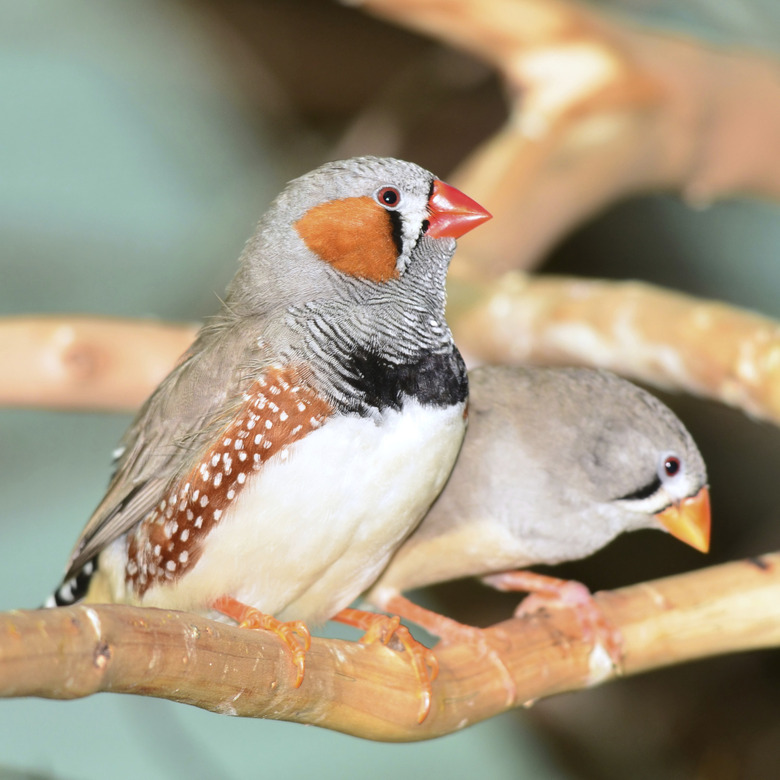The Differences Between Male & Female Finches
Whether you are interested in breeding finches or simply want to bestow a gender-appropriate name on a pet finch, consider various clues to determine your birds' sexes, such as the finch's coloring, vocal habits, and behavior. Color and pattern often provide solid clues, but they are not helpful for distinguishing between the males and females of all pet finch species. In such cases, your veterinarian can examine your bird's sex organs with an endoscope or analyze your bird's genetic material to determine gender with 100 percent certainty.
Subjective sex determination methods
Subjective sex determination methods
Because many pet finch species are sexually dimorphic (meaning the sexes look different), the relative brightness of a finch's colors often indicates gender — male finches generally possess bolder, more flamboyant markings than females. However, this method is problematic for immature individuals and species that bear eclipse plumages after their breeding season has ended, during which both sexes appear identical. This phenomenon occurs in strawberry finches (Amandava amandava) and orange weaver finches (Ploceus aurantius), among other species.
Some experienced bird keepers and breeders palpate the pelvic bones to determine sex, but this is rarely accurate when performed by novices. Additionally, as finch pelvic bones are incredibly fragile, pelvic palpation is not appropriate for inexperienced hands.
Objective sex determination methods
Objective sex determination methods
By inserting a small camera through your bird's skin and into the abdominal airsacs, your veterinarian can visualize the reproductive organs of the animal and determine its sex with certainty. Alternatively, your veterinarian can assist you in obtaining blood or feather samples for genetic testing, in which a diagnostic laboratory will analyze the genetic code of your bird to determine its sex.
Behavioral differences may indicate the sex of a finch; for example, the males of most finch species are the only ones to sing. Exceptions to this rule include purple grenadiers (Uraeginthus ianthinogaster), fire finches (Lagonosticta spp.), violet-eared waxbills (Uraeginthus granatinus), and melba finches (Pytilia melba), in which the females may sing as well. Of course, birds who deposit eggs are female, but this does not mean that birds who do not produce eggs are definitively male.
Male vs. female zebra finch
Male vs. female zebra finch
The combination of color pattern and vocal habits distinguish male zebra finches (Taeniopygia guttata) from female zebra finches. Males begin singing at about 35 days of age, while females do not sing at all. In most cases, a zebra finch displaying cheek patches, spotted sides or a bar across the breast is male; females typically lack these markings. However, some visual mutations alter the colors or markings of the animals, which renders such clues ineffective.
Male vs female Gouldian finches
Male vs female Gouldian finches
You can usually distinguish male Gouldian finches (Erythrura gouldiae) from female Gouldian finches by observing their colors. Although the exact differences vary from one color form to another, males almost always possess bolder colors than females do. For example, when considering individuals with purple breasts, males exhibit darker purple coloration than females do.
In general, animals with immaculate head colors — be they purple, yellow, or red — are male, while those with slightly dingy, black-flecked heads are females. The males of some color forms, such as black-headed variations, usually have brighter neck rings than females do. Females frequently bear black beaks, especially during the breeding season.
Sexing other finch species
Sexing other finch species
It is more difficult to discern the sex of some other finch species. For example, spice finches (Lonchura punctulata) and society finches (Lonchura domestica) bear essentially identical plumages, making them impossible to distinguish between the sexes at a glance; you must listen for their song or seek veterinary assistance instead.
Vocal behavior is helpful for distinguishing between male and female green singer finches (Serinus mozambicus), as the males often spend copious amounts of time singing. However, singer finches also possess subtle differences in color; for example, males possess more green coloration than females do. Females also have dark-colored "necklaces" that distinguishes them from males.
